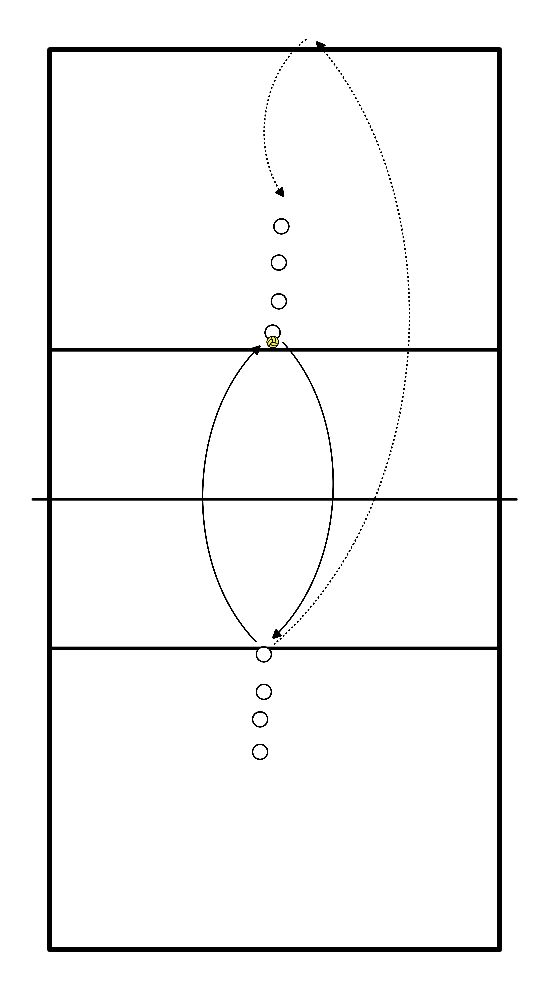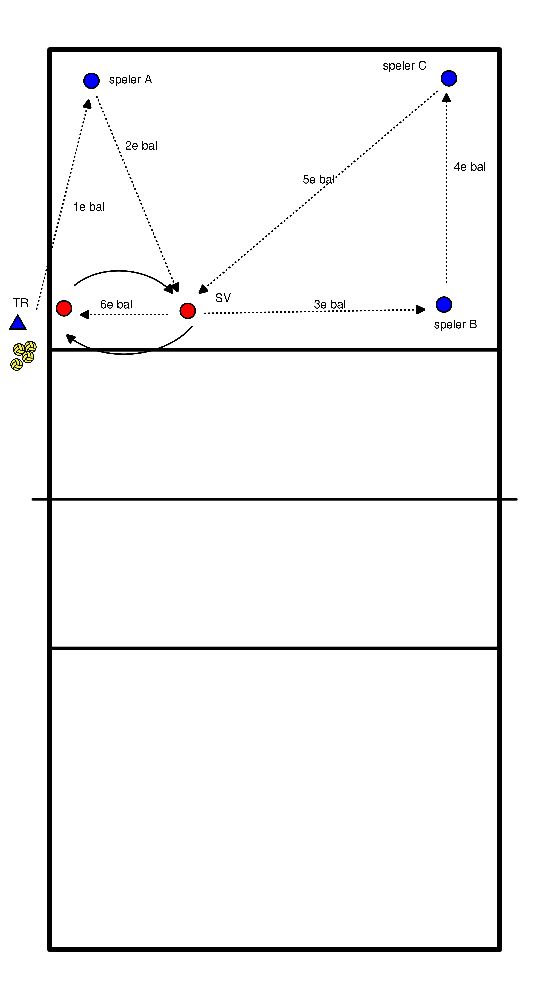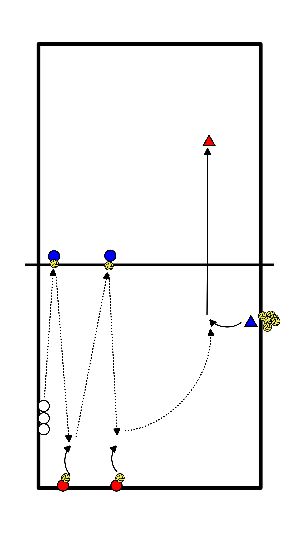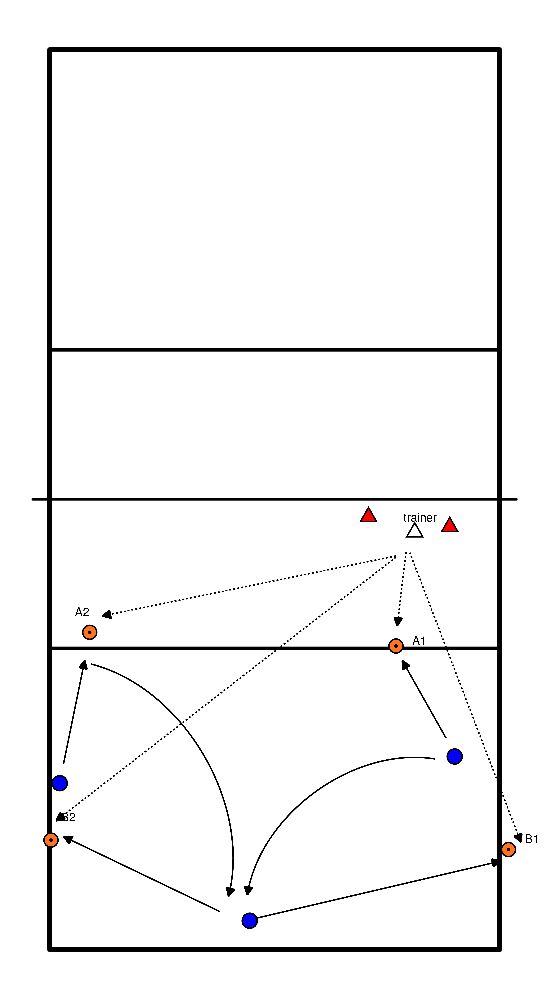Volleyball drills for
- Organization:
- Divide 2 quads on both fields.
- Players stand on 3m-line.
- The first player on field A has a ball.
- Implementation:
- Player on field A with the ball throws it with 2 hands from the neck over the net, runs under the net over the backline and joins behind it.
- The first player on field B catches the ball and throws it back and runs under the net as well.
- Regularly change the way of throwing: with: right hand, with left hand and throws from chest height.
- After 2 or 3 minutes let the bra play. Now it is no longer necessary to walk over the back line.
- After 2 minutes, make a block jump before passing under the net.
- Then after the block jump, move sideways and make another block jump.
- Attention point:
- The rally must be kept going.
- In case BH cannot be played, OH may be played.

- Code warm-up game.
- You make 2 or 3 groups.
- You come up with a code of about 8 numbers. {depending on the condition of the team}
- Say my code is 11325543.
- 1- 2 x run to the net and back.
- 2- 5x abs.
- 3- 5 times blocking.
- 4- 2 x dive.
- 5- 20 seconds in sitting position against the wall.
- The pair tries to decipher the code.
- They do 1 of the 5 exercises, then come to the trainer to see if the number is correct.
- If yes:
- May they try to guess the next one.
- If no:
- They have to choose another number to guess the code.
- Who deciphers the code first, wins.
- There is one passer in the field at position [6].
- The trainer or a playmaker stands with the balls at the net at position [3].
- The ball is introduced by hitting or pricking and there is a variation in short/long and hard/soft.
- The passer keeps the ball from the ground (prio 1) and provides the pass to [2/3] (prio 2) where the ball is caught by a team mate.
- This exercise can be played in two variants.
- A. [suitable for large teams]
- After the pass, a new player is rotated into the field and the passer joins the back of the line.
- High tempo!
- The team can be split in two, so that one team always picks up the balls from the other team.
- B. [suitable for small teams]
- The passer remains standing.
- He quickly takes up his position again after the pass and processes a new ball (10 in total).
- The other players spread out to collect the balls.
- After 10 passes the passer takes off and the ball is passed.
- High tempo!
- Make 3 team, per team 1 ball and 1 bench.
- Benches at equal distance (triangle with 3 teams).
- Teams try to score by bouncing the ball on an opponent's bench each time.
- 1 point each time. Never the same person in a row.
- The teammate defends the bench.
- Which team will have 10 points first?
- Variation:
- No running with the ball (i.e. throwing).
- Per person 1 hoop.
- Running next to the hoop, take as many steps as possible with your left foot through the hoop.
- Running next to the hoop, take as many steps as possible with your right foot through the hoop.
- Running next to the hoop, tapping the ground with your left hand through the hoop.
- Running next to the hoop, tapping the ground with the right hand through the hoop.
- Overtake the hoop and let it roll between your legs.
- Next:
- Throw in tight in pairs (3x*) and keep the hoop moving in front of/next to you.
- Pass over and immediately crawl through your own hoop.
- Overplay OH and roll over the hoop.
- Organization:
- 2 on P2 with 1 ball.
- 1 player on 4 and 1 on 6.
- Implementation:
- Player on 1 plays bra to 4.
- From 4 a technical attack on p6.
- Pass to P2 and again a setup to p4.
- Running direction:
- From p2 to p4 to p5 to p2.
- TR --> throws the ball to player A.
- Player S --> pass to SV.
- SV --> setup to player B.
- Player B --> pass to --> player C.
- Player C --> pass to SV.
- SV setup on diagonal to reserve SV.
- Back up SV catches --> ball in ball pit.
- After 10 substitutions of SV.
- When both SVs have been through, the other players turn one spot --> the exercise starts again.
- When there are more than 5 players, split the group in two. (Possibly an extra passer.

- 5 full laps in run around the field, bouncing left-right.
- Then all on the sideline: (6 -6):
- Ball on the ground, sitting low to halfway around the field and back (10 X).
- Ball on ground, sideways low moving to opposite side, rolling back ball and inciting to dive and arrive at opposite side in front of ball again.
- Ball 2 x BH up and 3rd ball BH forward, etc to opposite side and AW back in the same way.
- Same as OH.
- 2 x 6 before the 3 m line, throw ball over the net into the opposite side's backfield and catch after 1 bounce.
- In 2 pairs:
- In 2 x BH pass over and flat on belly, get back up as soon as possible and continue playing.
- 8 x controlled attacks after which the roles are reversed without stopping.
- Defender with back to attacker when kicking ball on front feet, on signal to turn around to defend (10 x).
- (Defender passes ball back to player at the net, turns around and taps back line, sprints forward and defends ball on 3m-line.
- (Russian passing-drill (1.10 min)
- Organization:
- 2 players with ball at the end of a bench at the net on field B.
- Libero at position 5 on field B.
- 2 players with ball on the backline on field A.
- Trainer with balls at the right side of field A.
- Remaining players at position 5 on field A.
- Implementation:
- 1st player comes running at p4, blocks ball.
- On coming down the player on the back line p6 throws up the ball.
- Blocking player is going to play this ball up and then runs back.
- For a 2nd block to then defend the back line.
- Then trainer throws a ball on the 3m-line to be attacked on L.
- Pick up the ball and give it to the trainer.
- Solving points:
- Do not start too fanatically.
- Regularly change the players on the bench and on the back line.

- The first student picks up the second and they have to return to the starting point with the hoop around their waists.
- Nr 1 holds the wall with one hand.
- Nr 2 picks up nr 3 and holds on to nr 1.
- And so on.
- When everybody is picked up, a long chain is formed and everybody has to try to get through the hoop.
- Each player has a sit up ball - 9 different core-stability exercises
- The Grasshopper:
- To get the most benefit from this exercise, make sure your body is in a straight line from head to toe, your hips are square (parallel to the ground) and your abs are tucked in and braced.
- Your hips should not sink at all during the movement, especially when you return to full length from the knees inwards.
- Another important point is to make sure your shoulders fall over your hands at all times, so your body doesn't rock back and forth, largely losing the benefit of this stability ball exercise.
- If you have sensitive wrists, use a pair of dumbbells as a base for your hands, this will keep your wrists in a more neutral position and reduce their strain.
- Push ups:
- Keep your hands on the side of the ball so your wrists are more neutral and very slowly lower to the ball to make this a good challenge.
- Just before your torso hits the ball, explosively (yet controlled) push back up.
- Straight Leg Deadbug:
- To get the most out of this exercise, make sure your arms and legs are always pressed into the ball.
- Even if you extend one arm and leg to just above the ground, the leg and arm still holding the ball should be pressed into the ball.
- Back leg position:
- Place your arms to the side or under the lower back if more support is needed there.
- Start with your legs perpendicular to the ground and on either side of the ball.
- Then rotate your legs so that your right leg is in front of the ball (facing you), while your left leg is on the other side (facing away from you).
- Pause at the end of each turn and then turn again so that the legs are reversed.
- Hamstring Roll-Ins:
- The key is to keep your hips high the entire time, so that your body is in a straight diagonal line from your feet to your head.
- Dig your heels into the ball as you drag it back to your buttocks.
- Squeeze your hamstrings and return SLOWLY to your legs fully extended (remember to keep your hips up).
- Ball Sensitive Twists:
- Start with your hands on the ground, shoulders above your hands, abs braced, body in a straight line and feet on either side of the ball, activating your groins to keep your legs from slipping.
- This alone is a huge benefit.
- Next, slowly rotate your hips to the right so that your foot touches the ground.
- Use your obliques to pull your hips back square and then to the other side.
- Remember to keep your hips at shoulder height the entire time.
- Ball Planks:
- Here I want you to dig your forearms and especially your wrists into the ball.
- This alone will increase your core activation 10-fold.
- Tighten and brace your abs, keep your hips up, and glutes and quads contracted.
- Next, simply move the ball around in a small circular motion, moving only your arms.
- Your whole body should stay still like cemented concrete.
- Lateral Scratch Runs:
- The ball should be under your head and shoulders and feel like a pillow, while your arms are stretched out to the side and fully locked/contracted.
- As with all of these stability ball exercises, the key with this one is to make sure your hips are up and your body is in a straight line from your knees to your shoulders.
- Push-Ups:
- This is a pretty easy move as you go down and pull your knees towards your wrists.
- This, of course, also causes the ball to roll inward.
- But the real test begins when you push yourself out of this "tucked in" position. Try it and convince yourself.
- Short/long.
- Trainer throws ball to position A1.
- Player 1 passes the short ball and runs to the middle.
- Trainer throws ball to position B1.
- Player 2 tries to pass ball back from A2, and gets ready for ball on A1.
- Then trainer switches to the other side.
- Trainer throws ball to A2.
- Player 2 passes the short ball and runs to the middle.
- Coach throws ball on to B2.
- Player 1 tries to pass ball on B2, and stands ready for ball on A2.
- Other players?
- Three get balls.
- 3 encourage.
- After 10 balls, change groups.
- 2 trainers available?
- 1 trainer makes sure the player in the middle does not cheat by starting too fast. (and keep him/her in the middle).








